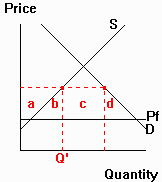| 2. |
Suppose you are hired as a trade policy
consultant to President Clinton. Indicate and carefully support what policy
recommendation, if any, you would make for each of the following (no graphs are necessary
for full credit, just careful reasoning): |
|
a. |
The Los Angeles Times recently reported that flat-panel
display screens (used in products such as laptop computers, instrument panels of cars and
aircraft, video telephones, high-definition TVs and hand-held personal communicators) are
a "dual-use technology" product: "The screens are prominent features of
laptop computers, but they are also being used increasingly in military equipment."
Domestic production of flat-panel display screens therefore has likely benefits for U.S.
national security purposes, but potential U.S. manufacturers cannot compete with
lower-cost flat-panel display screens manufactured in Japan. |
|
b. |
U.S. candle-making firms file a complaint about candles
imported from China and manufactured with "cheap Chinese labor." Research
indicates that candle-making workers are slightly more productive in the U.S. than in
China, but, because of far lower wages in China, the cost of making candles is lower in
China than in the U.S. |
|
c. |
Without safeguards, when fishing companies catch tuna, they
kill dolphins which swim with the tuna. To protect endangered dolphins, U.S. policy
requires that tuna be caught with dolphin-safe procedures. U.S. tuna fishing companies
file a complaint that tuna imported from Mexico is caught without using dolphin-safe
procedures. Research indicates that the complaint is true. |
 |
|
|
